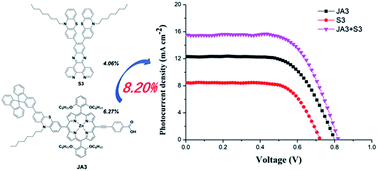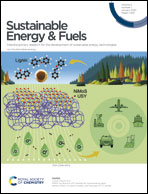Efficient cosensitization of new organic dyes containing bipyridine anchors with porphyrins for dye-sensitized solar cells†
Abstract
One of the core problems facing DSSCs is that they only partially absorb the solar spectrum, and a feasible solution is to co-sensitize two or more dyes with different absorption spectra to achieve panchromatic absorption. Herein, two organic dyes S3 and S4 containing bipyridine anchoring groups were prepared and used as co-sensitizers to assemble solar cells with porphyrin dye JA3. In the structural design of S3 and S4, we use diphenylthiazide and carbazole with a long carbon chain as electron donors and dipyridine with better planarity as an electron acceptor, and this is conducive to increasing the intramolecular charge transfer performance of dyes, inhibiting dye aggregation and increasing the amount of dye loading. Optical performance analysis shows that the light-harvesting ability of the device has been significantly improved after the co-sensitization of the two organic molecules with porphyrin dye JA3. At the same time, the charge recombination of porphyrin dyes has been significantly reduced because the appropriate molecular volume structures of S3 and S4 can fill the adsorption gap between porphyrin dyes. The DSSC based on JA3 shows a PCE of 6.23%, with a Voc of 801 mV, a Jsc of 12.23 mA cm−2, and a FF of 63.55%. After co-sensitization, the overall performance of the device has been significantly improved; both short-circuit current and open-circuit voltage have been greatly enhanced. The DSSC based on JA3 + S3 shows a high PCE of 8.20%, with a Voc of 821 mV, a Jsc of 15.46 mA cm−2, and a FF of 64.55%. The co-sensitizer not only successfully compensates for the absorption defects of porphyrin dyes in the range of 500–600 nm and improves the light response current, but also fills the adsorption gap between the main dyes, and effectively suppresses the charge recombination behavior, thus improving the open-circuit voltage of the device.



 Please wait while we load your content...
Please wait while we load your content...